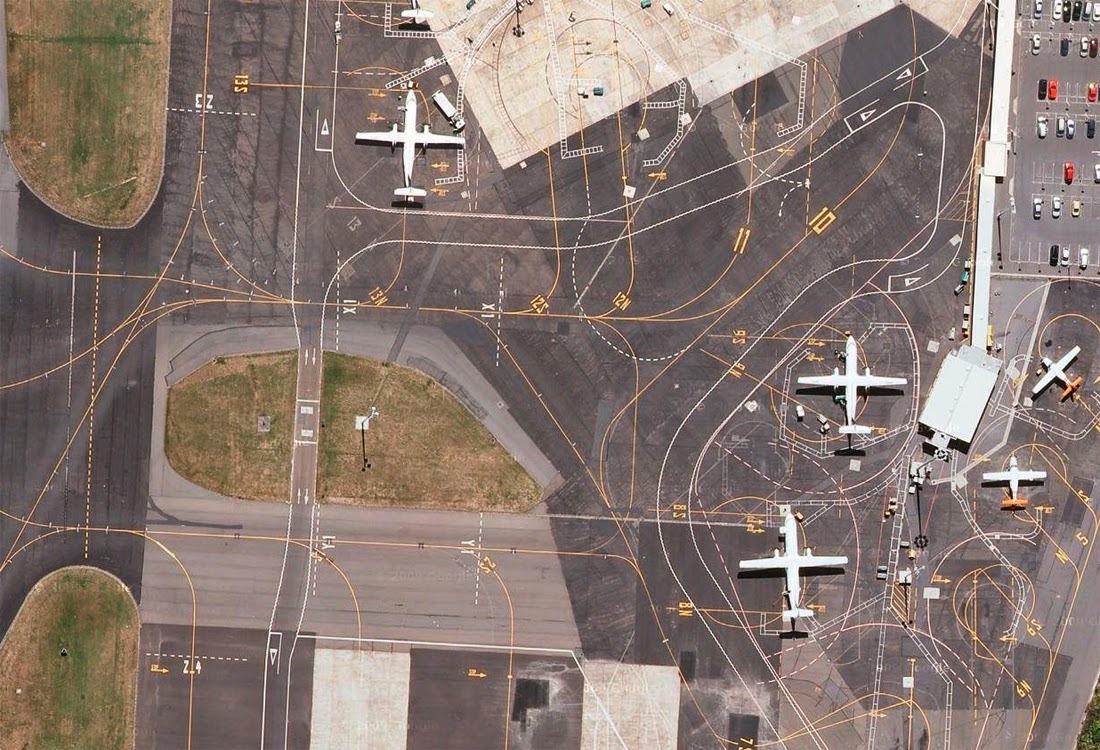I've always been fascinated by airports. I think what impresses me about them the most is that they remind me of some giant living organisms, taking planes in and dispatching them. These perfectly organized systems are built according to various rules and regulations and have a stunning number of markings and signs which most of the people are completely unaware of.
Naturally, I'm not alone in this fascination but a person who acted upon it in a really peculiar way is Lauren O'Neill, a graphic designer and an art director who started a project named Holding Pattern. Of course I instantly fell in love with it. Lauren collects satellite images of airports using Google Maps. Her curiosity takes her to zooming on various airports across the globe and her intuition for beautiful leads her to cropping the perfect image.
These images really put things in another perspective and reveal the logic behind all those signs and lines we see at the airports. Lauren's project has driven me into compiling a small list of the facts related to airports and runways which I became aware of quite late in my life. Some of you might find it useful and some will probably just find it silly.
1.Yellow lines and markings are used on taxiways and white ones are used on the runways BUT in Norway and some other countries yellow lines and markings are used on the runways instead of the usual white ones, in order to make the better contrast against the snow.
2. Runways are named by a number between 01 and 36. These numbers actually tell you to which direction the runway points. For example, runway numbered 36 points to the north ( 360°) , runway 18 points to the south (180°), runway 09 points to the east (90°), runway 27 points to the west (270°).
3. Every runway has a distinctive marking of the threshold which tells the pilot that it is the safest part of the runway for touching the ground when landing a plane.
4. By night, each of those different colored flashing lights has its own role. Blue lights run alongside taxiways and white or yellow run alongside runways. Also, green lights mark the beginning while red indicate the end of the runway.
I'll finish off with few more loving images from Holding Pattern.
Naturally, I'm not alone in this fascination but a person who acted upon it in a really peculiar way is Lauren O'Neill, a graphic designer and an art director who started a project named Holding Pattern. Of course I instantly fell in love with it. Lauren collects satellite images of airports using Google Maps. Her curiosity takes her to zooming on various airports across the globe and her intuition for beautiful leads her to cropping the perfect image.
 |
| London Heathrow Airport, via Holding Pattern |
 |
| Wellington International Airport, via Holding Pattern |
 |
| McCarran International Airport, via Holding Pattern |
These images really put things in another perspective and reveal the logic behind all those signs and lines we see at the airports. Lauren's project has driven me into compiling a small list of the facts related to airports and runways which I became aware of quite late in my life. Some of you might find it useful and some will probably just find it silly.
1.Yellow lines and markings are used on taxiways and white ones are used on the runways BUT in Norway and some other countries yellow lines and markings are used on the runways instead of the usual white ones, in order to make the better contrast against the snow.
2. Runways are named by a number between 01 and 36. These numbers actually tell you to which direction the runway points. For example, runway numbered 36 points to the north ( 360°) , runway 18 points to the south (180°), runway 09 points to the east (90°), runway 27 points to the west (270°).
3. Every runway has a distinctive marking of the threshold which tells the pilot that it is the safest part of the runway for touching the ground when landing a plane.
4. By night, each of those different colored flashing lights has its own role. Blue lights run alongside taxiways and white or yellow run alongside runways. Also, green lights mark the beginning while red indicate the end of the runway.
I'll finish off with few more loving images from Holding Pattern.
 |
| Madrid–Barajas Airport, via Holding Pattern |
 |
| Newark Liberty International Airport, via Holding Pattern |




